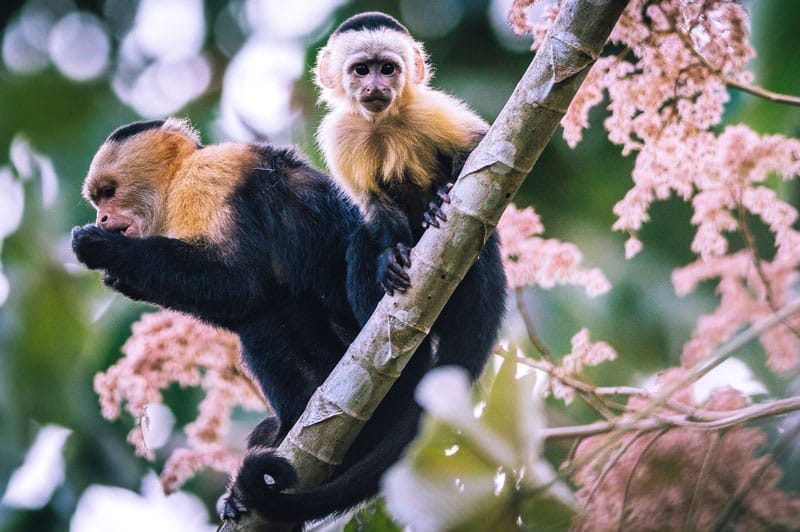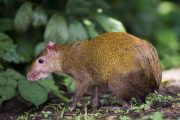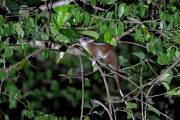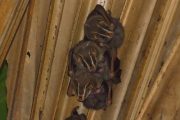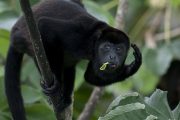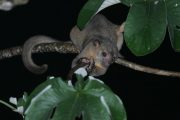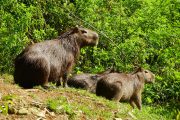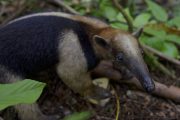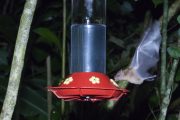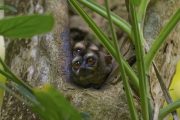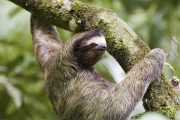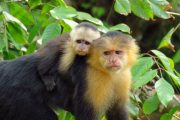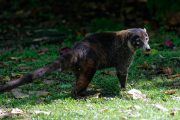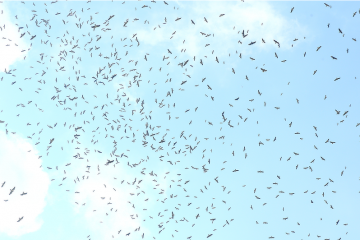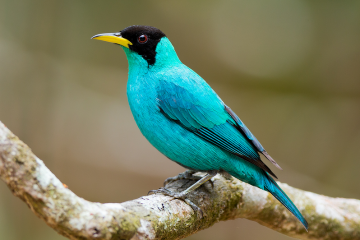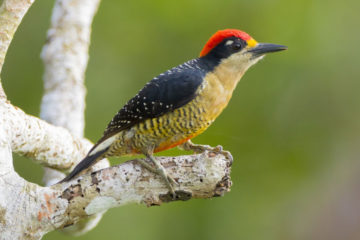An exciting 9-night tour specializing in mammals, but also featuring birds and more! Enjoy 7 nights lodging at the historic and world-famous Canopy Tower, with tours around the Canopy Tower and Semaphore Hill, Pipeline Road, Barro Colorado Island, a boat trip to Gatun Lake, Panama Rainforest Discovery Center, Metropolitan Nature Park and Fort San Lorenzo on the Caribbean coast. Also enjoy 2 nights at the award-winning Canopy Lodge, where we explore El Valle’s foothills for its amazing mammals and birds. From the diminutive Geoffroy’s Tamarin to the boisterous Mantled Howler, the incredible Hoffmann’s Two-toed & Brown-throated Three-toed Sloths to tongue-slurping Orange Nectar Bats, the Tamarin Tour will give you a great sampling of Panama’s incredible diversity of mammals and many other interesting creatures!
9 Night Package (2025): High Season: $4,347 — Green Season: $2,743
9 Night Package (2026): High Season: $4,478 — Green Season: $2,826
Rates in US$ per person (+ taxes), double occupancy
9-night, all-inclusive Wildlife Adventure
Neotropical mammals are a fascinating faunal group, with many unique members, including sloths, New World monkeys, anteaters, armadillos and more, that cannot be found in any other region on earth. There are parts of the world, such as Africa, where we are dazzled by the abundance of large mammals like elephants, giraffes and lions, out in the open and easy to see. Mammal watching in Latin America can be a little more challenging, but no less fun! The majority of the mammals here are small to medium-sized, and many are predominantly nocturnal. This wildlife adventure is tailored to finding the unique and interesting mammals of the Neotropics. We will strive to find diurnal mammals like monkeys, agoutis, coatis and tamanduas during the day; at night, we will venture out with our spotlight to search for nocturnal mammals, such as kinkajous, opossums and bats. The forests of central Panama are full of mammals, and although it may take a little searching, finding Neotropical mammals is memorable and rewarding! While looking for mammals, we will also take advantage of the forests around us to find other interesting organisms – there will never be a dull moment on this wildlife adventure!
Day 1
Arrival & Orientation
Today we will be picked up at Tocumen International Airport and then board a comfortable van and transfer to Canopy Tower. After settling in, we will meet our local guide on the observation deck where we may spot our first mammal, a Brown-throated Three-toed Sloth, munching on Cecropia leaves. During dinner, keep an eye on the Cecropia trees, as they attract nocturnal Kinkajous, Olingos, Central American Woolly Opossums and Western Night Monkeys. Black-and-white Owls are often around the Canopy Tower after dark too! Dinner at CANOPY TOWER.
Day 2
AM: Observation Deck & Semaphore Hill Road
We will start our wildlife adventure at sunrise on the observation deck on the Canopy Tower. The Canopy Tower’s observation deck offers a great opportunity to scan the treetops, where we can often see Geoffroy’s Tamarins, Mantled Howlers, Hoffmann’s Two-toed & Brown-throated Three-toed Sloths, Red-tailed & Variegated Squirrels and a variety of colorful birds that come to feed on the Cecropia trees. Toucans, parrots, a wide range of tanagers and flycatchers, majestic raptors and even Blue Cotinga can be seen from the observation deck. Breakfast will follow. After breakfast, we will start walking down Semaphore Hill Road through the lush lowland rainforest of Soberania National Park to continue our search for mammals and other creatures. On this road there is a chance to find two species of sloth, as well as Central American Agouti, White-nosed Coati, Mantled Howler and Northern Tamandua. The rare Silky Anteater, as well as the secretive Tayra, have been spotted occasionally along this road. The road is a little more than a mile long, and passes through some of the most beautiful forest around! We also have a great chance for forest birds including five species of trogon, Rufous & Broad-billed Motmots, and several species of antbird. At the bottom of the hill we can check under the bridge for roosting Greater White-lined and Chestnut Sac-winged Bats. At the end of this walk, we will get picked up by one of our open-air vehicles and driven back up to the CANOPY TOWER for lunch.
PM: Ammo Ponds & Gamboa Marina (20 minutes from Canopy Tower)
After lunch and a “siesta,” we will drive north to the Ammo Dump Ponds, located in the small town of Gamboa. This is a great place to look for the world’s second largest rodent, the Lesser Capybara, which can be found in or near the Chagres river. Also, in Gamboa’s forested neighborhoods, we search for Red-tailed Squirrel and Central American Agouti, a large diurnal rainforest rodent. Depending on time, we will make a quick stop at the marina on the Chagres River, the main source of water for the Panama Canal. With a bit of luck, we can find a Neotropical River Otter or a Variegated Squirrel. Waterbirds including Wattled Jacana, Striated Heron and the beautiful Snail Kite can be seen here. Dinner at CANOPY TOWER. After dinner we board one of the Canopy Tower’s open-air vehicles for a night drive down Semaphore Hill Road. Many Neotropical mammals are nocturnal, and night drives are the best way to find them! We hope this evening to find Olingo, Western Night Monkey, Paca, Central American Woolly Opossum and, if lucky, Rothschild’s Porcupine!
Day 3
AM: Pipeline Road (25 minutes from Canopy Tower)
This morning after an early breakfast, we will board the Canopy Tower’s Birdmobile and spend the morning at the world famous Pipeline Road. Hundreds of species of birds, mammals and countless insects and plants have been recorded here. This 17-km gravel road with eleven creeks has much to be explored, and is a great place for mammals, including White-faced Capuchin, Mantled Howler, Central American Agouti, White-nosed Coati, Tayra, Collared Peccary and White-tailed Deer. We will keep an eye on the openings of tree cavities for roosting Rufous Tree Rat. There have also been sightings of three species of cats here, namely Jaguarundi, Ocelot and, rarest of all, Jaguar. Over 500 species of birds have been recorded here, so there are good chances we will enjoy quality sightings of Crimson-crested Woodpecker, White-tailed Trogon, Spotted Antbird, Tiny Hawk or any number of special birds! We head back to the CANOPY TOWER for lunch.
PM: Summit Gardens & Old Gamboa Road (10 minutes from Canopy Tower)
After lunch, we will continue our wildlife adventure at the Summit Botanical Garden, just 10 minutes from the tower. Our main target here will be to find a roosting colony of Common Tent-making Bats under the large palm leaves at the entrance to the park. Agoutis are conspicuous and unshy here, and other mammals are always a possibility. Great Black Hawk, Crane Hawk, Giant Cowbird, Yellow-backed Oriole and Masked Tityra also may be seen! After a short visit to the gardens, we will cross the road to explore the area of Old Gamboa Road and the adjacent Summit Ponds. This site boasts the nearest access to Pacific dry forest from the Canopy Tower. The ponds are a great place to look for some secretive herons, including Boat-billed & Capped, and the diminutive American Pygmy Kingfisher, along with Spectacled Caiman and Common Basilisk, also known as the “Jesus Christ Lizard” for its ability to run across the surface of the water. Carrying on down Old Gamboa Road south, we hope to encounter Tayra, Red-tailed Squirrel, more Two-toed and Three-toed Sloths, Jaguarundi, White-nosed Coati and other mammals we have yet to encounter. Back at the Canopy Tower, we will review our checklist and enjoy happy hour prior to dinner. During dinner, Little Mastiff Bats may be seen flying around the dining room as they head out for their evening hunt, and we will watch for the largest bat in the Americas, the Great False Vampire Bat, hunting around the Cecropia trees out the windows. Dinner at CANOPY TOWER.
This evening after dinner, we will head out on another night drive, targeting nocturnal mammals. Common Opossum, Nine-banded Armadillo, Northern Tamandua and Collared Peccary are some additional targets on our nighttime wildlife adventure!
Day 4
San Lorenzo National Park FULL DAY (1.5 hours from Canopy Tower)
Today after an early breakfast, we will drive to the Caribbean slope of Panama, only 1½ hours from Panama City, over a newly constructed four-lane highway. The purpose of this day’s tour will be to look for mammals at San Lorenzo Forest Preserve, where we will also enjoy a picnic-style lunch. This area was the site of the US Army Jungle Training School, and is also known as Fort Sherman. San Lorenzo National Park is known for its abundance of Mantled Howlers, White-faced Capuchins and sloths. Some other elusive species, such as Jaguarundi and Western Night Monkeys are often seen. Occasionally, visitors are surprised by a herd of Collared Peccaries or a White-tailed Deer crossing the road. There is also the added benefit of visiting the old Spanish fortress of San Lorenzo, a World Heritage Site, built on a promontory at the entrance of the Chagres River. This fort was the last bastion of the Spanish Empire on mainland America and was abandoned by the Spanish in 1821. In the dark rooms of the fort, we may find Greater White-lined Bats and perhaps some other species inside. In addition, to get to this area, we have to cross the Panama Canal, which gives us a unique view of the Gatun locks and new Agua Clara locks from below. Dinner at CANOPY TOWER.
Day 5
AM: Jungle Boat Tour (15 minutes from Canopy Tower)
This morning after breakfast we board a motorboat for a spectacular tour on the Panama Canal. Most of the Panama Canal is actually an artificial lake, Gatun Lake, and this wildlife adventure will depart from Gamboa, just 15 minutes from the Canopy Tower. We start in the Chagres River, enjoying the abundance of water birds and keeping an eye out for Lesser Capybara. Then we pass under the historic one-way Gamboa bridge into the Panama Canal! Along the way we will pass huge cargo ships and ocean liners and will also visit hidden coves and beautiful inlets of Gatun Lake with fascinating fauna and flora. From the boat, we will explore the small islands throughout the lake to look for primates including Mantled Howlers, White-faced Capuchins and the tiny Geoffroy’s Tamarins. There is also a chance to see the American Crocodile (some reach 14 or more feet in length) and its smaller relative, the Spectacled Caiman, plus Basilisks and Black River Turtles. A little scarcer, but not impossible, are the Neotropical River Otter and, if we are really lucky, the West Indian Manatee. This species was introduced to the Panama Canal in the 1960s to control the growth of water weeds, and they have adjusted very well to this habitat. We also hope to see the tiny Proboscis Bat, often found roosting along these quiet banks. We are sure to have a fantastic morning! Lunch at CANOPY TOWER.
PM: Panama Rainforest Discovery Center (30 minutes from Canopy Tower)
This afternoon after a little rest, we return to the Pipeline Road to visit the Panama Rainforest Discovery Center, an ecotourism and environmental education facility created and administrated by Fundación Avifauna Eugene Eisenmann. Seventy percent of the materials used in the construction of this facility were recycled from old Canal Zone houses. We will climb the observation tower up to the top of the canopy, overlooking vast Soberania National Park. From this vantage, we scan the tree tops for mammals and hawks! Purple-throated Fruitcrow, Yellow-throated Toucan, Pied & White-necked Puffbirds and Blue Cotinga are commonly seen from the top of the tower. The platform and its hummingbird feeders offer us an opportunity to see several species prior to dusk. Two-toed & Three-toed Sloths, White-nosed Coati and Northern Tamandua may be found here! Dinner at CANOPY TOWER.
Tonight after dinner we will head out on our last night drive to continue our search for nocturnal mammals, hoping to find Ocelot, Collared Peccary, Paca, Western Night Monkey, Silky Anteater, Rothschild’s Porcupine or something else.
Day 6
AM: Metro Park & Punta Culebra (30 minutes from Canopy Tower)
After breakfast, we head to Metropolitan Natural Park, located right next to Panama City, and only 30 minutes from the Canopy Tower. The forests of the Metro Park are much drier than those around the Tower. This park is also a great place for bird migration (September through October). There is a wonderful over-look at the summit of a hill, which will give us an incredible perspective of Panama City, the scenic bay and some of the closer islands. Some of the most common residents are Geoffroy’s Tamarins and Variegated & Red-tailed Squirrels. Northern Tamandua, White-nosed Coati and Western Night Monkey are also a possibility for us this morning. Rosy Thrush-Tanager, Black-throated Trogon, Green Shrike-Vireo and the endemic Yellow-green Tyrannulet can also be found here!
Later this morning we will head into Panama City to the Amador Causeway to visit Punta Culebra Nature Center, a public nature facility run by the Smithsonian Tropical Research Institute. Our main target for this site is the Crab-eating Raccoon, a shy mammal that lives in the Pacific dry forest and adjacent mangroves. Also Hoffmann’s Two-toed Sloths are especially abundant and easy to find here, and Northern Tamandua is commonly seen. Lunch at CANOPY TOWER.
PM: Miraflores Locks (20 minutes from Canopy Tower)
After lunch, we visit one of the “must see” attractions on any trip to Panama, the world famous Panama Canal! The newly expanded Panama Canal is one of the wonders of the modern world and an engineering marvel. There are four exhibition halls at this ultra-modern museum, which includes historic artifacts used in the construction of the Canal, interactive modules, video presentations, models of the Panama Canal, and objects used in Canal operations. Models of the biota collected during the construction are also on display. Most importantly, we will watch the huge cargo ships negotiate the tight-fitting locks! After this fascinating visit we head back for happy hour and then dinner at CANOPY TOWER.
Day 7
AM: Pipeline Road (25 minutes from Canopy Tower)
This morning, we take a well-deserved trip back to the Pipeline Road. Pipeline Road is so biodiverse that one morning here is not enough! This morning we will walk a little further into the park, reaching wetter Caribbean slope forest and hoping to see some different mammals and birds. Tayra, Collared Peccary and Jaguarundi are all possibilities this morning as we head further up Pipeline Road. We will keep an eye out for Rufous Tree Rat and the rare Silky Anteater as well. Streak-chested Antpitta, Great Tinamou, Tiny Hawk and Slaty-backed Forest-Falcon are just some of the birds we hope to encounter this morning. After a full morning on Pipeline Road, we head back to the CANOPY TOWER for lunch.
PM: Chagres River wrap up (35 minutes from Canopy Tower) / Gamboa Wildlife Center visit (35 minutes from Canopy Tower)
For our last afternoon at the Canopy Tower, we can revisit the Chagres River around Gamboa or tailor our quest for Neotropical mammals in search of any that we have yet to see. Perhaps a Neotropical River Otter or Northern Tamandua are still waiting to be seen! We will also pay a visit to the Gamboa Wildlife Center, a newly-opened public facility located in Ciudad del Saber and owned and operated by the APPC, Panamerican Association for Conservation. Passionately run by a team of wildlife rehabilitators and educators, this center takes in injured and orphaned wildlife from across the country. Their ambassador animal is the sloth, and they receive dozens of orphaned and injured sloths every year, along with many other species. Their goal is to rehabilitate every animal that comes through their facility in hopes that it can be released back into the wild, and educate locals and visitors to Panama about conservation. This afternoon we will meet their staff, hear about the work they do and their conservation message, and meet the animals currently in their care. A visit to the Gamboa Wildlife Center is an enjoyable and meaningful experience! Donations are welcome to support their work. This evening, we will meet during cocktail hour to review our growing checklist and enjoy dinner at CANOPY TOWER.
Day 8
AM: Plantation Road & transfer to Canopy Lodge
For our last morning at the Canopy Tower, we can enjoy the Observation Deck at dawn followed by breakfast. After checking out, we will take a short drive down to the bottom of Semaphore Hill to Plantation Road, one of Soberania National Park’s trails. It is a good, easy graded dirt road, passing through a mature forest for about four miles. The road follows a small creek, the Chico Masambi River. This trail features some incredible forest, including gigantic Wild Cashew, Ficus, and Cuipo Trees that reach heights of more than 100 feet. During this walk there is a chance to find more Mantled Howlers, Geoffroy’s Tamarins and White-faced Capuchins. There is also the possibility of encountering a Northern Tamandua or even a Central American Spider Monkey!
After a short walk, we return to the Tower mid-morning, load up our luggage and transfer to the Canopy Lodge in El Valle de Anton, in the foothills of Central Panama, about 2 hours west of the Canopy Tower. El Valle is located in the caldera of a gigantic volcano that erupted 3.5 million years ago. It is the largest inhabited caldera in the western hemisphere. The volcano has been dormant for many years, but there are mud baths and thermal pools in certain areas of the caldera. Both the Canopy Lodge and the town where it is located are just delightful. When we arrive at the Lodge, it is usually hard to get to your room since visitors are hypnotized by the several colorful tanagers visiting the feeders—not to mention the very pleasant cooler temperatures! The altitude here is about 700 meters above sea level. Upon arrival, we can enjoy the flurry of activity at the lodge’s feeders, where Collared Aracari, Thick-billed Euphonia, Dusky-faced & Flame-rumped Tanagers and many more species feast on the bananas. Lunch at CANOPY LODGE.
PM: Canopy Lodge Gardens & Canopy Adventure Trails (5 minutes from Canopy Lodge)
After having lunch and enjoying the bird feeders, we will take a walk on some of the trails near the Lodge, and this will include a visit to Chorro El Macho at the Canopy Adventure, a 36-metre high waterfall. We come back to the CANOPY LODGE in time for happy hour and dinner.
The Canopy Lodge is a great place to catch up on some of the mammals we may have missed at the Tower and to add some additional foothill specialties to our lists. After dinner we will take a leisurely night walk around the lodge grounds. Some of the nocturnal mammals often seen in this area are Gray Four-eyed, Common & Water Opossums, Rothschild’s Porcupines, Western Night Monkeys, Ocelots and Orange Nectar Bats, which visit the hummingbird feeders at night!
Day 9
AM: La Mesa & Finca Candelario (15 minutes from Canopy Lodge)
After being awakened by the morning chorus of birds and having our breakfast, we will go out again in search of any other species that is still missing from our list. This time we will visit two sites: La Mesa, the flatlands up along the rim of the crater, within the protected area of Cerro Gaital Natural Monument, and Finca Candelario, a private and well-maintained property with tranquil trails and a pleasing open area to explore. Both these areas are great places to look for Western Pygmy Squirrel, Greater Grison, Rufous Tree Rat, Rothschild’s Porcupine, Tayra and Jaguarundi. Lunch at CANOPY TOWER.
PM: Cara Iguana (10 minutes from Canopy Lodge)
After lunch and a siesta, we head to Cara Iguana, a quiet road on the outskirts of El Valle, this area boasts quality dry forest at the roadsides. Here we hope to see any mammals we have not yet encountered, perhaps White-tailed Deer or Jaguarundi, along with the likelihood of Two-toed and Three-toed Sloths and Central American Agouti. We will also check for roosting Spectacled Owls. Lance-tailed Manakin, Tody Motmot, Garden Emerald and White-winged Becard are just a few of the birding possibilities here! Our last afternoon of the tour is sure to be an enjoyable one. Back at the Canopy Lodge we will review our final checklist and reminisce about our favorite moments of the tour. Dinner at CANOPY LODGE.
Day 10
Departure
After breakfast we depart to for Panama City to catch our return flight home, with memories of the many species of mammals, birds, insects and other wonders of the Neotropics seen and photographed on this wildlife adventure!
Please note that the itinerary is flexible, and may change without prior notice due to weather, alterations in habitat or other conditions.
Canopy Tower
The Canopy Tower is located in impressive rainforest atop Semaphore Hill within Soberanía National Park, 35 miles north of Panamá City in the Republic of Panamá right in the center of the New World— and just 2½ hours from Miami! It’s one of best locations for birding lodges in Panama.
Canopy Lodge
El Valle de Antón In Coclé Province, home to both the Canopy Lodge and the Canopy Adventure, is an enchanting mountain valley town much cooler than the tropical lowlands. Surrounded by scenic misty mountains traversed by creeks, its true charm is revealed by its unhurried pace and its peaceful residents. Located just two hours from Panama City, El Valle is the perfect resting place for someone trying to escape traffic jams, office buildings, pollution and the pressures of everyday city life.

